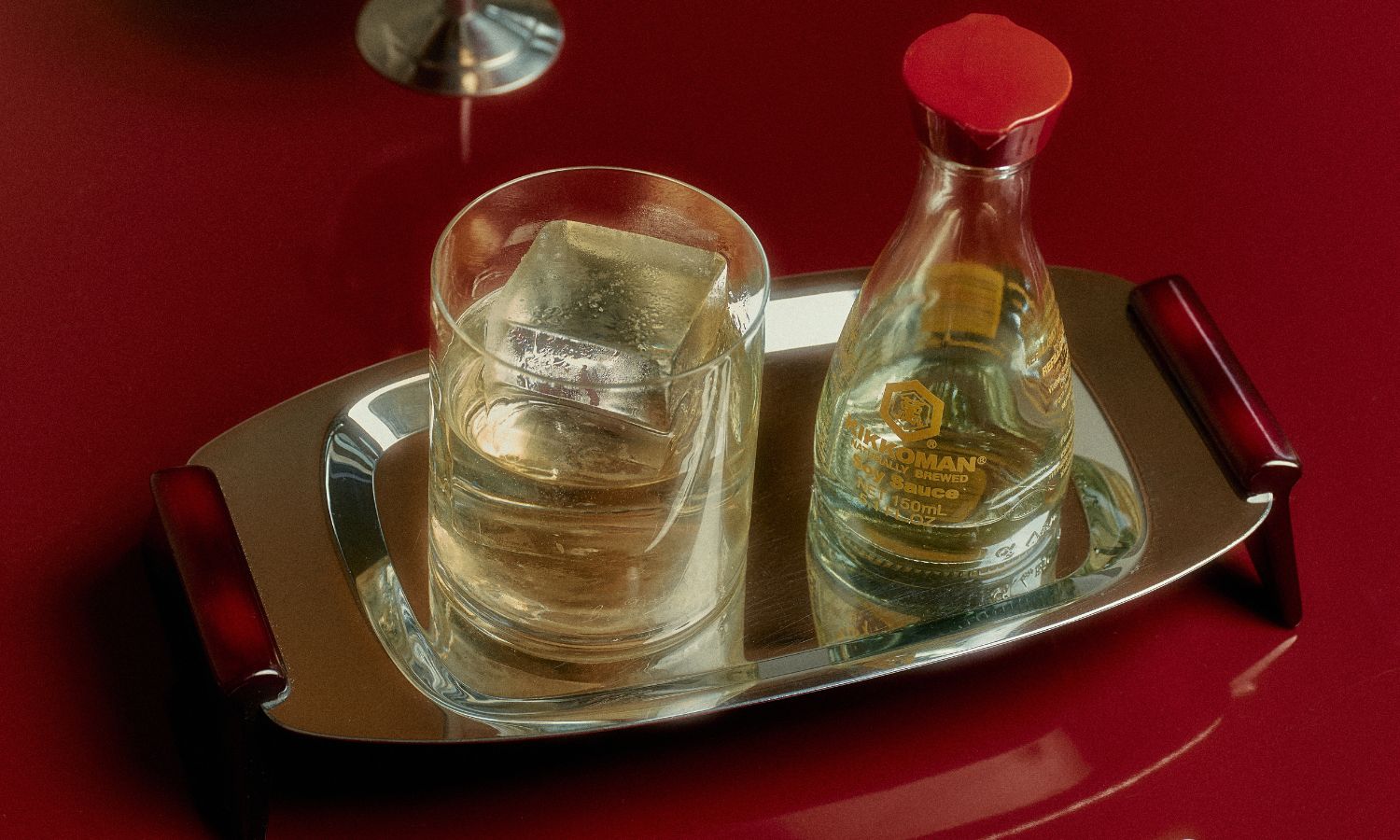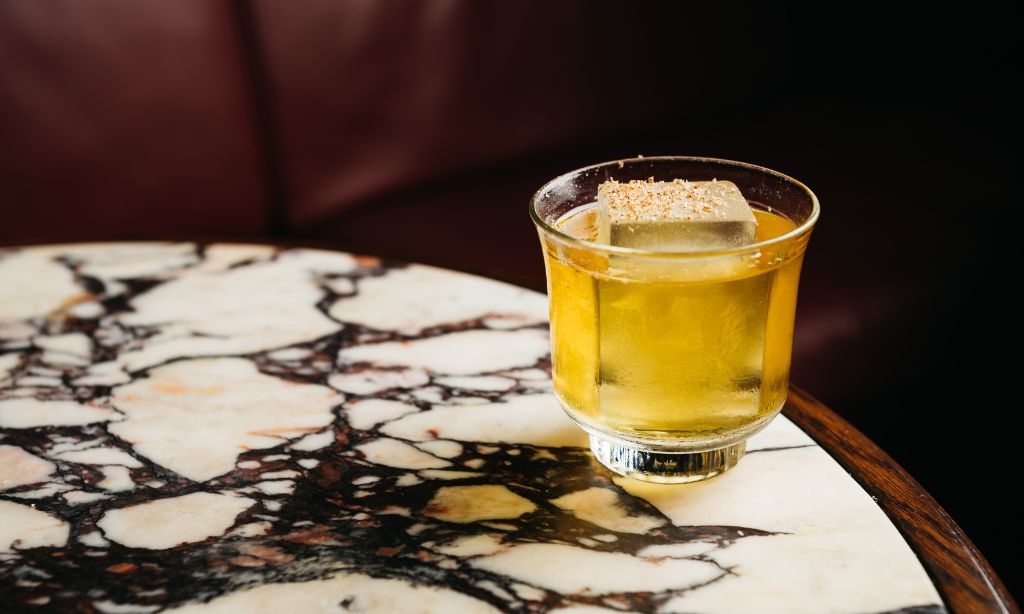You wouldn’t guess what ‘milk punch’ is from its name. It’s a cocktail of milk, spirit, sugar and vanilla extract. But it’s also the shortened version of ‘clarified milk punch’ or ‘English milk punch’, a drink technique. In verb form, it’s ‘milk punching’.
You get it by mixing citrus, milk and spirit (brandy, bourbon or rum). When the acid and milk mix, the milk coagulates and curdles and the curds are then strained out. The result? A clear drink with softened flavours and overall cohesion.
“Milk is a different way of putting flavours into a drink that isn’t a syrup or ferment or distillation but still gives you clean, surprising results,” Darren Leaney of Melbourne venue Capitano told Diffords Guide.
I first came across milk punching when Merivale group creative cocktail lead James Irvine explained it was used in a cocktail at Good Luck Restaurant: the Matcha Kit Kat. In that drink, matcha was curdled into coconut using yuzu juice.

“By doing so, the drink is completely clarified, resulting in a crystalised cocktail with unreal body and a profound balance of weight, acidity and flavour,” Irvine said. “In its simplest form, milk punching is a clarification method of altering the pH balance in protein through acids — not dissimilar to making ricotta.”
Milk punching is also used in cocktails at Sydney’s Maybe Sammy, Vinabar, Apollonia and Smoke. Reece Griffiths, group bars manager at Solotel (owner of Smoke), says the best milk punch drink he’s tasted is Leaney’s tiramisu milk punch at Capitano. Irvine at Merivale also says he’s a fan of Leaney’s drink.
“Bar Totti’s once served a tiramisu milk punch which used the by-product of the kitchen to create a tiramisu whey,” he says. “The drink looked like an Old Fashioned but drank like a dessert.”
The earliest record of milk punch came in 1688 when William Sacheverell mentioned the cocktail in his travelog of Scottish Isle of Iona, reports US drinks publication Vine Pair. The first recipe was written in a cookbook by Mary Rockett in 1711. After this, milk punch started gaining popularity and even Benjamin Franklin had a recipe for it.
Griffiths thinks part of the popularity of milk punch drinks is that they’re easy for bartenders to serve. All the work is done in the prep stage so it’s simple to make. Hunter Gregory, Maybe Sammy’s bar manager, puts it: milk punches are friendly to bartenders.
“Providing a ready-to-pour cocktail allows bars to make drinks faster and more efficiently,” Gregory says. “It also allows the bartender designing the drinks to play more creatively to incorporate complex ingredients into their drinks.”
Maybe Sammy serves several milk punch-style drinks including a cocktail called Concierge that combines condensed and macadamia milk with Vegemite. A rich, umami flavour develops and the drink is then carbonated.
“Milk punches in general are super delicious ways to translate difficult ingredients into drinks,” Gregory says. “We use this technique at Maybe Sammy for aesthetic and textural reasons. Through the milk clarification process, colours and textures can be minimised and enhanced. We’ve been carbonating these milk punches lately.”
“Milk punching has seen a massive resurgence as it creates layered cocktails with loads of ingredients, techniques and flavours,” says Griffiths. “It has a long shelf life and can be served in a simple pour from a bottle. Also the contrast between a crystal clear cocktail and the complex flavour profile plays with your senses a lot.”
If you can’t get to Capitano to try the tiramisu milk punch, Apollonia serves a version too. The drink is made with the ingredients used in the dessert infused into liquids and then strained out.
“It’s fantastic in place of a dessert or it can be a great nightcap,” says Jason Williams, group beverage director of House Made Hospitality (owner of Apollonia). “Milk punches are often low alcohol and you can have fun with the flavour of milk drinks without the creamy, cloying texture.”
At Vinabar, milk punch is used in a margarita twist. Several spirits including tequila, makegoli (traditional Korean alcoholic drink) and triple sec blend with citric acid and calamnsi (Phillippine lime). The milk is added and then the curd filtered. The result is a clear, almost-silky mixture served on the rocks — called Gaslighter.
“Colloquially gaslighting refers to making someone question their reality,” says Tony Yang, mixologist at Vinabar. “In this context, as our venue is dark and moody, the cocktail looks like water but tastes like a margarita twist. Hence the name.”
Yang thinks milk punch’s renewed popularity is because of social media and the evolution of mixology and drinking culture. More people are being exposed to the mixology world and their appetite for cocktails has increased. As more people see milk punch creations, more people create, more people share and more people demand.
“This sudden popularity has brought many mixologists to see what twists we can come up with and the cycle continues,” he says.
So what’s ahead for the milk punch? Will it continue its renewed rise in popularity? Gregory says it will continue to evolve. The clarification process isn’t just milk now — other fat sources like yoghurt, cream and alternative milks are being used. They provide a greater development to the milk punch. Carbonation is also part of its evolution.
Williams says the current trend twist on milk punch is fun dessert or snack-inspired versions. One Solotel venue will soon serve an Iced VoVo milk punch. Yang at Vinabar is experimenting with an acid-less milk punch clarification but says drink trends are changing rapidly so it’s hard to predict how long it will remain popular. Finally Griffiths thinks milk punches will always have a place but only the best versions.
“There are a lot of awful milk punches floating around,” Griffith says. “Not everything should be clarified. It should enhance the cocktail not detract from it.”
Related: Matcha Cocktails Are Trending
Related: Australia’s Saying Oui Oui to French Restaurants Again
Read more stories from The Latch and subscribe to our email newsletter.

